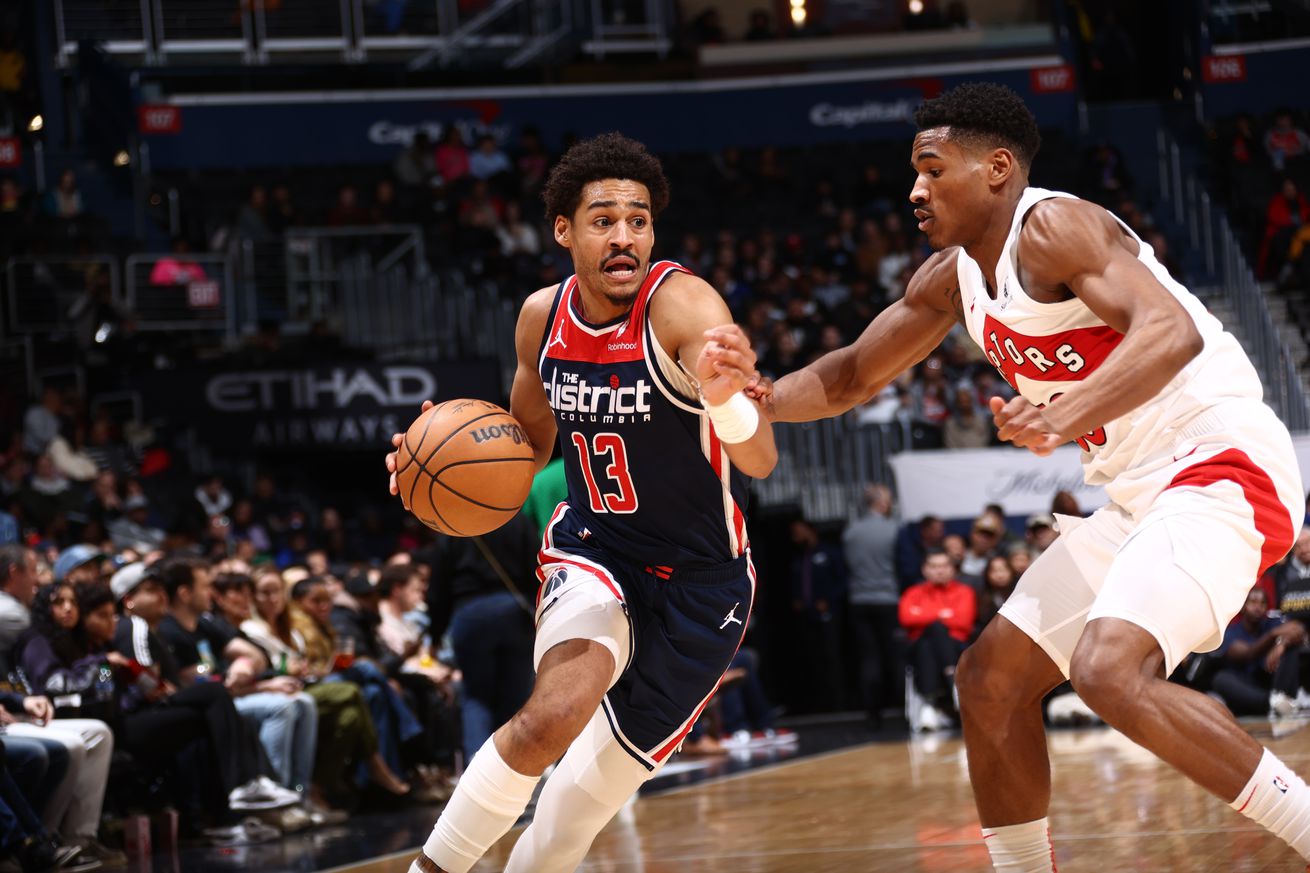
Stats, analysis, commentary.
In last Thursday’s win against the Sacramento Kings, the Washington Wizards relied on Kyle Kuzma to lead the way while the rest of the roster chipped in just enough to bring home the victory. Against the the Toronto Raptors, the rest of the roster carried Kuzma through a rough game and collected their second straight win for the third time this season.
Don’t get too chesty about this one. The Raptors traded away two of their best players earlier in the season (because the team wasn’t much good even with them), and they’re even more ravaged injuries than the Wizards have been the past week or so. Missing from this game: Immanuel Quickley (personal reasons), RJ Barrett (personal reasons), Jakob Poeltl (thumb), Scottie Barnes (hand), Chris Boucher (knee), and even a few more backups.
Wizards interim head coach Brian Keefe wasn’t dealing with a full deck either. Out for the Wizards were Tyus Jones (back), Bilal Coulibaly (wrist), Landry Shamet (calf), Eugene Omoruyi (ankle), and Isaiah Livers (hip).
Washington got back Marvin Bagley III, and 2023 second round pick Tristan Vukcevic made his NBA debut.
The Recitation of Woes out of the way, the players remaining suited up and played an actual game. It was pretty close throughout. The Raptors seemed like they were going to break the game open when their lead hit 11 in the third quarter, but Washington roared back and took the lead for good on a Corey Kispert three with 4:52 to play.
Jordan Poole provided a few of his standard terrible shots and head-scratching turnovers. He also compiled 12 assists to just three turnovers, and came up with three steals. This was one of his better games in a Wizards uniform, and he still has some easy fixes that would improve his production considerably.
Deni Avdija didn’t shoot great (8-19 from the floor and 3-8 from three — good for a 50.0% effective field goal percentage), but he defended, pushed the pace, attacked the paint (six free throws, though he made just three), grabbed 13 rebounds (including three on the offensive end), and had five assists.
The Wizards held their own for the first few minutes of the fourth quarter with a lineup of Avdija and four bench guys. He led the way with defensive effort and crisp passing.
If you think Richaun Holmes was the best player for the Wizards last night, I’m not going to argue. He dominated inside with 15 points on 6-9 shooting, and 14 rebounds (7 on the offensive end). Raptors center Kelly Olynyk couldn’t keep Holmes off the glass and nearly fouled out contending with Holmes’ strength and physicality.
Kispert made shots — 7-12 from the floor and 4-6 from deep. I thought his defense was iffy, and he didn’t contribute playmaking or rebounding, but efficient scoring is valuable, especially in a game where both teams struggled on the offensive end.
Bagley hit the boards in his return from back spasms — 8 rebounds in 16 minutes, plus a couple blocks.
Johnny Davis worked on the defensive end and got free for a couple layups. This is probably the model for any possible success he’ll have as an NBA player unless he can fix his shot.
Kuzma had a crummy game — 16 points on 7-18 shooting, including 0-3 from deep and 2-4 from the free throw line. He also had four turnovers and four fouls. That’s a lot of negatives to overcome. He did contribute 9 defensive rebounds and 5 assists.
Vukcevic got three minutes in his first NBA game. He grabbed a rebound and that’s all there is to say about that.
Four Factors
Below are the four factors that decide wins and losses in basketball — shooting (efg), rebounding (offensive rebounds), ball handling (turnovers), fouling (free throws made).
Stats & Metrics
Below are a few performance metrics, including the Player Production Average (PPA) Game Score. PPA is my overall production metric, which credits players for things they do that help a team win (scoring, rebounding, playmaking, defending) and dings them for things that hurt (missed shots, turnovers, bad defense, fouls).
Game Score (GmSC) converts individual production into points on the scoreboard. The scale is the same as points and reflects each player’s total contributions for the game. The lowest possible GmSC is zero.
PPA is a per possession metric designed for larger data sets. In small sample sizes, the numbers can get weird. In PPA, 100 is average, higher is better and replacement level is 45. For a single game, replacement level isn’t much use, and I reiterate the caution about small samples sometimes producing weird results.
POSS is the number of possessions each player was on the floor in this game.
ORTG = offensive rating, which is points produced per individual possessions x 100. League average last season was 114.8. Points produced is not the same as points scored. It includes the value of assists and offensive rebounds, as well as sharing credit when receiving an assist.
USG = offensive usage rate. Average is 20%.
ORTG and USG are versions of stats created by former Wizards assistant coach Dean Oliver and modified by me. ORTG is an efficiency measure that accounts for the value of shooting, offensive rebounds, assists and turnovers. USG includes shooting from the floor and free throw line, offensive rebounds, assists and turnovers.
+PTS = “Plus Points” is a measure of the points gained or lost by each player based on their efficiency in this game compared to league average efficiency on the same number of possessions. A player with an offensive rating (points produced per possession x 100) of 100 who uses 20 possessions would produce 20 points. If the league average efficiency is 114, the league — on average — would produced 22.8 points in the same 20 possessions. So, the player in this hypothetical would have a +PTS score of -2.8.

